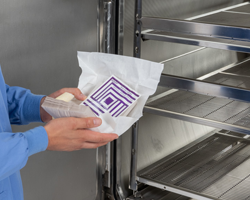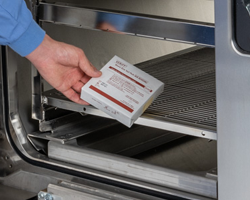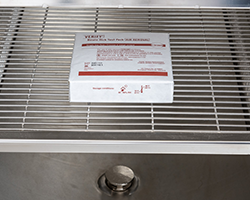
Bowie-Dick (Air-Removal) tests evaluate the performance of prevacuum sterilizers by confirming adequate air removal from the sterilizer chamber. These air removal tests have been improved over the years, but you may be wondering if Bowie-Dick tests are still relevant in sterilizers that have programmed leak tests.
If I run a Leak Test Cycle, do I still need to use a Bowie-Dick Test? Yes – If you conduct a vacuum leak test, you still need to run a Bowie-Dick (Air-Removal) Test, and vice-versa. These diagnostic tests are intended to complement one another and play a vital role in ensuring an effective steam sterilization process. To learn more, read our article: The Importance of Leak Tests in Steam Sterilization.

To fully answer why Bowie-Dick tests are still important today, we must first understand why removing air from the sterilizer is important. The air within a steam sterilizer is often referred to as a non-condensable gas (NCG). As the name indicates, non-condensable gases do not condense when touching a colder item. These gases act like a shield between the steam and the item, potentially shielding bacteria and preventing proper sterilization. Even today’s sterilizers are not capable of detecting NCG because it could be hiding anywhere in the chamber. Sensors would need to be placed within the packs exactly where the NCG would either be trapped or collected to detect it. This is not possible, which supports why air-removal tests are still very relevant to today’s modern sterilizers for autoclave testing. The Vacuum Leak Test programmed on your autoclave only measures the integrity of the sealed pressure vessel and associated piping to ensure air is not admitted to the sterilizer during the vacuum drawdowns.
In addition to air removal, modern Bowie-Dick Tests, such as the VERIFY ® Bowie-Dick Test Pack, provide a critical control for sterilizer performance and verification of steam quality. It ensures the sterilizer can provide the validated preconditioning required and aid in the detection of steam quality that could interfere with the sterilization of complex instrumentation.
Interested in Earning FREE Continuing Education (CE) Credits? Earn 1.0 CE hours by learning about Bowie-Dick tests and the key considerations when selecting a Bowie-Dick test for your facility. View the STERIS University course

Recommended use of a Bowie-Dick Test is outlined in the Association for the Advancement of Medical Instrumentation's (AAMI) guidance ANSI/AAMI ST79 Comprehensive Guide to steam sterilization and sterility assurance in health care facilities. Bowie-Dick Tests are used to qualify sterilizer performance when first installed, when it is moved, and after a major repair. This is qualification testing and requires three consecutive test cycles with passing results. Bowie-Dick Tests are also used each day the sterilizer is in operation, and only one passing test cycle is required for routine monitoring. The Bowie-Dick Test procedure is the same for both qualification and routine testing. Step 1: Perform a warm-up cycle. This critical step is needed to heat the sterilizer properly, and it can result in false failed Bowie-Dick Test results when not performed. It is the most common step missed, resulting in unnecessary downtime.
The Importance of the Steam Sterilizer Warm-Up Cycle Sterilizers that have been turned off or idle should always have a short warm-up cycle run before Bowie-Dick or Leak Testing. By running the warm-up cycle, sterilizer components reach their operating temperature and will reduce the failure of tests caused by cold components that contribute to air leaks.

Step 2: Place the test pack. A Bowie-Dick Test pack must be placed in the most difficult spot to sterilize (refer to sterilizer operator manual for placement; typically, it is on the sterilizer's bottom rack or cart directly over the chamber drain). The drain is where the vacuum is drawn, and any residual air in the chamber will naturally migrate to the test pack. Step 3: Ensure the chamber is empty. Only the sterilizer cart (on medium and floor loader sterilizers) should be present for a proper test. If the cart is not included, the result could be superheated steam and a failed test. Step 4: Run the cycle. ANSI/AAMI ST79 does not provide specific guidance on cycle parameters for the test. However, it does indicate that the programmed exposure time should be between 3.5 and 4 minutes. Always follow the sterilizer and Bowie-Dick Test pack's instructions for use on cycle parameters for testing.
Tip – The top sources of a failed Bowie-Dick Test are:
1. Door Gasket/Air Leak
2. Steam Supply Issues
3. Steam Trap or Safety Valve Failures
Step 5: Open the test pack and interpret the results. Interpreting a Bowie-Dick Test pack varies by manufacturer and can show you more than air leaks. It can also provide information, including moisture presence, steam quality issues, and the presence of NCG in plumbing lines outside of the sterilizer. To assist, STERIS has developed A Bowie-Dick Troubleshooting Guide. Review the Bowie-Dick interpretation guide to understand better what a failed Bowie-Dick Test looks like to understand what needs to be done to avoid downtime.
Operators are instructed not to use a prevacuum cycle if the unit does not pass the Bowie-Dick test. However, the unit can still be used for a Gravity or Steam Flush Pressure Pulse (SFPP) cycle, which does not draw a vacuum during conditioning. Some causes of Bowie-Dick test failure are poor air removal, poor steam quality, and superheated steam conditions. Leaks in the piping can also be a source of failure. Always check with your steam sterilizer operator manual and facilities policy for complete instructions. STERIS has developed a Bowie-Dick Troubleshooting Guide. Review the Bowie-Dick interpretation guide to better understand what a failed Bowie-Dick Test looks like and what is needed to avoid downtime.